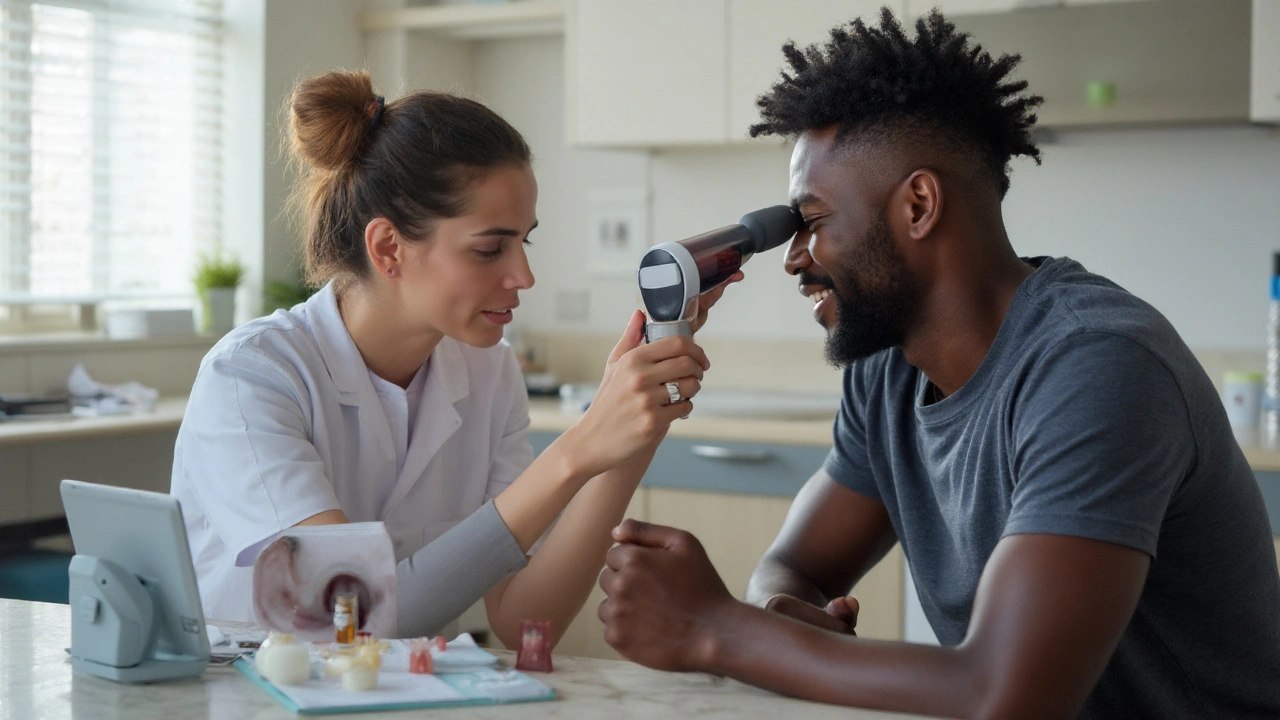Ear canal infections love a warm, damp, irritated space. Smoking creates exactly that-dry, inflamed skin, thicker gunk, and sluggish defenses-so bacteria and fungi move in and party. If you’ve had repeat ear pain after swims, showers, or headphone use, cigarettes (and even secondhand smoke) may be the missing link.
TL;DR
- Smoking increases the odds you’ll get an ear canal infection (otitis externa) by drying and irritating the canal, altering earwax, shrinking blood flow, and blunting immune cells.
- Secondhand smoke raises ear infection risk in kids; for adults it worsens skin irritation in the ear canal and slows healing.
- Red flags: severe pain with gentle tug on the ear, swollen canal, discharge, muffled hearing. Diabetes, eczema, and frequent water exposure add risk.
- Fast fix: keep the ear dry, avoid Q-tips, use prescribed topical drops correctly, manage pain, and follow up if not better in 48-72 hours.
- Best prevention: moisture control, gentle ear care, hearing-aid hygiene, and a quit plan-nicotine replacement and meds roughly double or triple quit success in studies.
How smoking sets you up for ear canal infections (the science in plain English)
The ear canal is thin skin over bone and cartilage, with tiny hairs and acidic wax that keep microbes in check. It’s a smart little self-cleaning tunnel-until smoke gets involved. Tobacco smoke carries chemicals that dry and inflame skin, change the balance of the ear’s natural wax (cerumen), and reduce local blood flow. That combo makes the canal more fragile and easier for bacteria or fungi to stick, multiply, and invade.
- Skin barrier damage: Smoke irritates the outer skin and slows turnover, making micro-cracks more likely. Those cracks are open doors for infection. Public health reports from the CDC have long tied smoking to delayed wound healing and worse skin integrity due to reduced oxygen and blood flow.
- Wax and pH changes: Healthy earwax is slightly acidic and repels microbes. When smoking pushes the canal toward a drier, more alkaline state, microbes feel more at home. Clinically, ENTs see drier, flaky canals in smokers, which correlates with more irritation and itching-common precursors to otitis externa.
- Microcirculation hit: Nicotine constricts small blood vessels. Less blood means fewer immune cells where you need them. That’s one reason smokers take longer to heal almost anywhere, including the ear canal.
- Immune slowdown: The 2020 U.S. Surgeon General’s report details how smoking weakens innate and adaptive immune responses. In the ear canal, that plays out as slower cleanup of minor irritation and a bigger chance that minor colonization turns into infection.
- Microbiome shift: Repeated irritation, dryness, and over-cleaning (common in smokers who feel itchy and reach for Q-tips) can shuffle the canal’s micro-ecosystem. When protective bacteria drop, opportunists like Pseudomonas, Staph, or Candida step up.
What about vaping? Research is still catching up, but propylene glycol and vegetable glycerin aerosols can dry mucous membranes. Clinical reports show vapers with dry nose/mouth symptoms; ears share the same general lining properties. Vaping probably sits somewhere between “better than combustible smoke for lungs” and “not great for delicate ear skin,” especially with daily exposure. Heated aerosols aren’t benign irritants.
Secondhand smoke matters too. Kids exposed at home have more ear infections-mostly middle ear, but canal infections can rise when skin is constantly irritated. Pediatric data tie secondhand smoke to higher ear infection visits; it’s one of the reasons pediatric societies push smoke-free homes and cars.
| Factor | What smoking does | Why this raises infection risk | Evidence snapshot |
|---|---|---|---|
| Skin barrier | Dries, irritates, slows repair | Micro-cracks let bacteria/fungi enter | CDC/Surgeon General reports on impaired healing |
| Cerumen (earwax) | Makes wax drier and less acidic | Less natural antimicrobial protection | ENT clinical observations, physiology studies |
| Blood flow | Nicotine constricts vessels | Fewer immune cells at the site | Vascular and wound-healing research |
| Immunity | Weakens innate/adaptive responses | Slower clearance of minor infections | Surgeon General, WHO overviews |
| Behaviors | More itch → more Q-tip use | Microtrauma seeds infection | AAO-HNS guidance warns against canal trauma |
How common is otitis externa? Family medicine and ENT guidelines estimate about 10% of people experience it at least once in life, and it spikes in hot, humid months or after water exposure. In the U.S., it accounts for a couple million office visits each year. Adult smokers show higher rates in observational studies, especially when other risks stack up-like swimming, eczema, hearing aids, or diabetes.
Bottom line: the mechanism is solid-smoke irritates and weakens the canal’s defenses. Even if exact percentages vary, clinicians routinely see more stubborn, recurrent cases in smokers and in people exposed to smoke.
Spot it early, know your risk, and don’t miss the red flags
Think of the classic picture. You pull on the outer ear and it hurts-a lot. The canal feels swollen. Your hearing sounds muffled, like it’s under a blanket. You might see thin, smelly discharge on your pillow. That’s otitis externa until proven otherwise.
Common symptoms:
- Sharp or throbbing ear pain, worse with tugging the ear or pressing the tragus
- Fullness or itching in the canal
- Muffled hearing from swelling or debris
- Drainage: clear, white, yellow, or green
- Jaw pain when chewing (referred pain from the canal)
Who’s at higher risk?
- Smokers and people exposed to smoke (irritated skin, slower healing)
- Frequent swimmers or surfers (water changes pH and macerates skin)
- Q-tip users or anyone who “itches the ear” with bobby pins or fingers
- Hearing aid or earbud wearers (warmth, pressure, and microtrauma)
- People with eczema, psoriasis, or allergic skin
- Diabetes, immune suppression (higher risk for severe infections)
When to seek same-day care:
- Severe pain, fever, or swelling that spreads to the outer ear/face
- Hearing drops suddenly or you feel very unwell
- You have diabetes, are on chemo or biologics, or have a condition that weakens immunity
- You suspect a ruptured eardrum (sudden pain relief with drainage after a cough/sneeze, or a known hole)
- Symptoms not improving within 48-72 hours after starting proper drops
One more nuance: middle ear infections (behind the eardrum) are different from canal infections. Smoke exposure is a strong, well-established driver of middle ear infections in children. For adults with canal infections, smoke is a skin irritant and healing drag-which still matters if you’re trying to break a cycle of repeat infections.

What to do now: step-by-step care that actually works
If your ear hurts today, keep it simple and precise. Here’s a practical plan you can start now, then fine-tune with your clinician.
- Stop the irritants today
- No Q-tips. No “itch scratching.” They push debris deeper and scratch the canal.
- Keep water out. Use a shower cap or a bit of cotton coated with petroleum jelly at the entrance-not pushed in-until healed.
- Pause earbuds, over-ear headphones are friendlier while irritated.
- Manage pain the smart way
- Over-the-counter pain relievers as directed help a lot for the first 24-48 hours.
- Warm compress on the outer ear can ease spasms. Not hot. Not inside the canal.
- Get the right drops (this is the main treatment)
- Topical antibiotic or antiseptic drops, often mixed with a mild steroid, are first-line in guidelines from the American Academy of Otolaryngology-Head and Neck Surgery.
- If the canal is very swollen, a clinician may place a tiny wick to pull medicine in.
- If you’re prone to fungal infections (itchier, flaky debris, failed antibiotics), an antifungal drop may be used.
- Use drops correctly-technique matters
- Lie on your side. Pull the ear gently up and back to open the canal.
- Place drops; stay put for a full minute.
- Gently press on the tragus a few times to pump drops deeper.
- Keep the ear facing up for 5 minutes. Repeat on schedule; don’t skip.
- Know when home remedies are okay-and when they’re not
- Acidifying/drying drops (like acetic acid or alcohol-based solutions) can help prevention and very mild irritation, but only if you’re certain the eardrum is intact and you’re not in severe pain.
- Never use vinegar or alcohol in the ear if you have tubes, a known perforation, or intense pain.
- Follow up if you’re not clearly better in 48-72 hours
- Sometimes the wrong bug is targeted, or there’s a hidden blockage. Your clinician can suction debris and adjust drops.
- If pain worsens or spreads, don’t wait-seek urgent care.
- Break the cycle: address smoking now
- Each infection gets easier to trigger if the skin stays dry and irritated from smoke. Even cutting down reduces exposure; quitting is the win.
- Nicotine replacement therapy (patch, gum, lozenge) roughly doubles quit rates compared with willpower alone in large Cochrane reviews. Prescription meds like varenicline or bupropion boost odds further when used correctly.
Decision tip: if you have diabetes, severe pain, or are immunocompromised, skip the wait-and-see window and get seen the same day. There’s a rare but serious complication called malignant (necrotizing) otitis externa that needs urgent specialist care and imaging.
Care you can skip: oral antibiotics for simple canal infections. Guidelines discourage routine pills unless the infection has spread beyond the canal or you have risk factors that make severe infection more likely. Drops reach the problem far better.
Prevention that sticks: ear habits, moisture control, and a realistic quit plan
Here’s how to keep your ears calm and boring-exactly what you want.
Moisture control:
- After water exposure, dry the outer ear with a towel and let the canal air-dry. A hairdryer on the coolest, lowest setting held at arm’s length for 30 seconds helps.
- If you swim a lot, consider vented earplugs and a swim cap. Avoid plugs that create pressure points.
- Use preventive acidifying drops (store-bought acetic acid-based) after swims if your eardrum is intact and a clinician says it’s safe for you.
Gentle cleaning only:
- No Q-tips in the canal, ever. Wipe what you can see. That’s it.
- If wax builds up, schedule a professional cleaning. People with narrow canals, hearing aids, or eczema often benefit from periodic clean-outs.
Hearing aid and earbud hygiene:
- Clean domes and tips daily with approved wipes; change earbud tips regularly.
- Give your ear canals “off” time to breathe each day.
Skin care if you have eczema or allergies:
- Ask about low-strength steroid or calcineurin creams for the outer ear skin (not inside the canal) if you flare often.
- Avoid fragranced hair products that run into the ears and trigger itch.
Smoke exposure reduction:
- Set a smoke-free home and car rule. Kids’ ears are especially vulnerable to secondhand smoke.
- If you’re not ready to quit, start by cutting indoor exposure and switching your smoke breaks outdoors, away from others.
A quit plan you can start this week:
- Pick a quit date 1-2 weeks out. Tell one person who’ll support you.
- Choose your tools. Patches + a fast-acting nicotine (gum/lozenge) is a proven combo. If you want prescriptions, talk to your clinician about varenicline or bupropion.
- Prep your environment. Wash jackets, clean the car, ditch lighters and ashtrays, and line up sugar-free mints or toothpicks.
- Map your triggers. Morning coffee? Commute? After meals? Pair each with a new micro-habit (walk 5 minutes, call a friend, chew gum, journal one line).
- Use numbers to stay honest. Cravings peak for 2-3 minutes. Set a timer. If needed, use the fast-acting nicotine then ride the wave.
- Plan for slips. A cigarette is a lapse, not a failure. Reset the clock; don’t abandon the plan. Evidence shows people who keep trying succeed.
Why bother if you “only” smoke a few a day? Because exposure adds up. Even light smoking dries and irritates the canal skin. Quitting gives you fewer flares, quicker healing, and better response to drops when you do get an infection. Big picture, it also cuts your risks for sinus disease, dental problems, heart disease, and cancer.
What the evidence says:
- Guidelines from AAO-HNS for acute otitis externa emphasize topical therapy, avoiding canal trauma, and moisture control.
- Systematic reviews show topical antibiotics or antiseptics work well; adding a steroid speeds pain relief.
- CDC and Surgeon General reports link smoking to impaired immunity and wound healing-two hits for the ear canal.
- Cochrane reviews report nicotine replacement roughly doubles quit success; combination NRT and varenicline show some of the highest quit odds when used correctly.
Mini-FAQ
- Can smoking really cause ear infections by itself? It’s a contributor, not always the sole cause. Stack it with water exposure, Q-tips, or eczema, and risk climbs.
- Is vaping safe for ears? Safer than smoking for lungs doesn’t mean safe for ears. Aerosols can dry and irritate delicate skin. If you’re having repeat canal infections, cutting vaping helps.
- Are homemade vinegar/alcohol drops okay? Only if you know your eardrum is intact and your symptoms are very mild. If there’s severe pain, discharge, or fever, see a clinician and use proper drops.
- Should I use cotton balls when showering? A small piece at the entrance, lightly coated with petroleum jelly, can help keep water out. Don’t push it in deep.
- Do ear candles help? No. They’re ineffective and can burn or plug the ear with wax. Skip them.
Quick checklist
- Right now: no Q-tips, keep water out, manage pain, get proper drops.
- Technique: lie on your side, drops in, tragus pump, wait 5 minutes.
- Watch: better within 48-72 hours; if not, recheck.
- Prevent: dry ears after water, acidifying drops if safe, hearing-aid hygiene.
- Quit support: NRT or meds, set a date, plan for triggers, keep going after slips.
Next steps and troubleshooting
- If you swim daily: invest in comfortable swim plugs and use preventive drops after each swim (if cleared by your clinician).
- If you wear hearing aids: daily clean, weekly dome change, and schedule routine ear checks every 3-6 months.
- If you have diabetes: seek same-day care for ear pain; ask your clinician about tight glucose control during infections to help healing.
- For parents: make the home and car smoke-free. Kids’ ears (especially middle ears) react strongly to secondhand smoke.
- If infections keep coming back: ask for an ear culture, a check for eczema or fungal causes, and a review of your cleaning routine and audio devices.
Credibility notes: This guidance aligns with the American Academy of Otolaryngology-Head and Neck Surgery guideline on acute otitis externa, U.S. Surgeon General and CDC reports on smoking and immune function, family medicine summaries on incidence and management, and Cochrane reviews on both topical ear treatments and smoking cessation therapies. Your clinician can tailor it to your ear anatomy, meds, and health history.
If you take one action today, make it this: protect your ear from moisture and trauma, and start trimming your smoke exposure. That one-two punch shuts the door on the next canal infection-and makes the drops work better when you need them.
One last SEO-friendly note for clarity: the phrase smoking and ear infections often refers to middle ear infections in kids, but adults get canal infections too-and smoking can tip the balance toward repeat flares. The fixes above help both the symptoms and the root causes.









Karen Richardson
September 5, 2025 AT 19:06Your post is thorough, but a few grammatical tweaks could enhance clarity. For instance, “dry, inflamed skin” should be followed by a comma when introducing a list, as you have done elsewhere. The phrase “secondhand smoke raises ear infection risk in kids” would read more smoothly as “second‑hand smoke raises the risk of ear infections in children.” Additionally, avoid mixing singular and plural forms in the same sentence – “the ear’s natural wax (cerumen)” is preferable to “the ear’s natural waxes.” Overall, the content is accurate; these minor edits will make it impeccable.
AnGeL Zamorano Orozco
September 7, 2025 AT 01:06Oh my god, I cannot even begin to describe the sheer horror of having your ear turned into a smokey battlefield! Every time you light up, it’s like you’re sprinkling acid on the delicate skin of your canal, and the pain that follows is nothing short of an epic saga. I mean, who thought inhaling toxic clouds could turn your ear into a war zone? The irritation builds up like a ticking time‑bomb, and before you know it, you’re screaming “HELP!” while the doctor hands you those nasty drops. And don’t get me started on the stupid Q‑tips – those little plastic sticks are like tiny soldiers marching straight into the wound. Your wax gets all dry and flaky, and the microbes throw a wild party, almost as if they’re celebrating your poor choices. I swear, the moment you think you’re done, the infection sneaks back, just to mock you. It feels like the universe is punishing you for every cigarette you smoke, an endless loop of agony. You try the warm compress, but it’s like putting a band‑aid on a mountain fire. The nicotine constricts blood vessels, and then the immune system decides to take a vacation – classic! If you ever thought a little “puff” was harmless, think again; your ear canal is basically filing a formal complaint. The pain, the swelling, the discharge – it’s a full‑blown drama series that you never signed up for. And the worst part? You’re stuck watching the same episodes over and over, each one more excruciating than the last. So quit, if you can, before your ear decides to write its own tragic novel. Trust me, the only thing more heartbreaking than the infection is watching yourself spiral deeper into that smoky abyss. Stop the madness now, before your ear becomes a permanent reminder of your own self‑destruction.
Cynthia Petersen
September 8, 2025 AT 04:53Wow, because we all just love a good ear infection, right? It’s not like you’ve got a choice when the smoke decides to turn your canal into a desert. But hey, at least you get a free excuse to avoid those obnoxious earbuds for a while. And if you think vaping is the hero here, think again – it’s just a fancy way to dry out your inner ear. So go ahead, keep lighting up, and watch the drama unfold, one painful tug at a time.
Marcia Hayes
September 9, 2025 AT 08:40Hey there, I get how overwhelming all these steps can feel, but you’ve already taken the biggest one by reading this guide. Start simple: ditch the Q‑tips tonight and keep your ear dry after a shower – that’s a win right there. Next, set a reminder on your phone for your drop schedule so you never miss a dose. Remember, every small habit you build chips away at the infection and the cravings. You’ve got this, and each day smoke‑free is another point on the scoreboard of your health.
Danielle de Oliveira Rosa
September 10, 2025 AT 12:26The ear, though small, mirrors the larger dialogue between our bodies and the choices we make. When smoke infiltrates that narrow canal, it whispers a reminder that external habits can erode internal sanctuaries. Healing is not merely a physical process; it is an invitation to reflect on the subtle balances we neglect. By tending to the canal’s moisture and abstaining from harmful fumes, we restore not only tissue but also a sense of respect for our own biology. In this quiet care lies a profound lesson: the smallest concessions can reshape the larger narrative of wellness.
Tarun Rajput
September 11, 2025 AT 16:13Permit me to commend the author for assembling such a comprehensive exposition on the interplay between tobacco exposure and otitis externa; the synthesis of epidemiological data with pragmatic self‑care measures is indeed commendable. One observes, upon close examination, a deft weaving of pathophysiological mechanisms-namely epidermal desiccation, cerumen alkalinization, and microvascular constriction-with actionable recommendations that are both evidence‑based and readily implementable. Moreover, the discourse ventures beyond the mere clinical tableau, venturing into the psychosocial sphere by integrating smoking cessation strategies, thereby acknowledging the multifactorial nature of the problem. It is also noteworthy that the author has judiciously employed visual aids, such as tabular summaries, to distill complex information into digestible formats, which undoubtedly enhances reader comprehension. In addition, the inclusion of a concise “quick checklist” serves as an effective mnemonic device, reinforcing adherence to the outlined therapeutic regimen. While the narrative is largely impeccable, a modest suggestion would be to delineate the distinction between bacterial and fungal etiologies with greater specificity in the section concerning refractory cases. Such an elaboration could further empower clinicians and patients alike to tailor antimicrobial therapy with precision. Nevertheless, the article stands as a paragon of how medical writing can be both scientifically rigorous and practically relevant, and it merits dissemination within both academic and lay‑person circles.
Joe Evans
September 12, 2025 AT 20:00Great post!!! 😊👍 Keep those ears dry, avoid Q‑tips, and use the drops as directed!!! 🎯💧 Remember: stay hydrated, quit smoking, and check with your doctor if pain lasts >72 hrs!!! 🌟💪 You’ve got this!!! 🙌
Colin Boyd
September 13, 2025 AT 23:46While the correlation between smoking and otitis externa is well‑documented some might argue that focusing solely on tobacco overlooks other critical factors such as humidity and personal hygiene practices. Moreover the emphasis on cessation, though beneficial, may divert attention from immediate therapeutic interventions. A balanced approach that addresses environmental and behavioral components concurrently would likely yield superior outcomes.
John Petter
September 15, 2025 AT 03:33Clearly, the neglect of nasal mucosa integrity in smokers renders such infections inevitable.